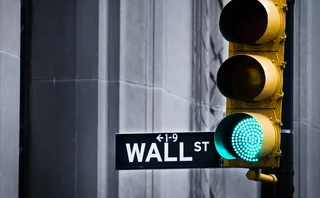
CDOs on the radar
Collateralized debt obligations have been a major factor in the recent run of spread tightening. Asset managers are discovering that they can no longer afford to ignore these instruments. Saskia Scholtes reports

In the three months running to early October, the investment-grade DJ CDX index tightened from 65 basis points to 53bp. This downward surge was just the latest sign of a broader tightening cycle which started in September last year. Of course, the credit market has experienced rallies before, and volatility has subsequently returned with the scandals plaguing the insurance market and poor performance in the auto sector, but the difference between this rally and others is the level from which it started and its virtual singularity of direction.
Last year’s rallies were recovery rallies—spreads were wide and consequently tightened—but they did not show the consecutive tightening of recent months. Equally, as spreads become ever tighter, the significance of each basis point of tightening becomes proportionately greater. But perhaps most importantly, this rally appears to have been driven mainly by technical factors. Asset managers seem universally convinced that collateralized debt obligations (CDOs)—specifically synthetic CDOs—are responsible for the tightening. All the investors that US Credit spoke to for this article offered CDOs as a core explanation of this spread movement.
Banks issuing synthetic CDOs buy protection via the credit default swap (CDS) market, which their credit derivative or correlation desks then hedge by buying cash bonds or selling protection on. Synthetic CDOs can have significant leverage so trading desks can suddenly come into the market with hundreds of millions of dollars in corporate risk on which they want to sell protection. Furthermore, the hedging of synthetic CDOs tends to take place quickly, putting intense pressure on the market (see box overleaf).
According to figures from Citigroup, the total US 2004 year-to-date primary issuance in the CDO market has reached a record level of $64 billion, and Citigroup expects this number to increase before the end of the year, as the visible pipeline remains robust at roughly $20 billion.
Kent Weber, portfolio manager at Axa Investment Managers, says, “The volume of CDO issuance has quite clearly caused spreads to march tighter, particularly in those parts of the market where the most fruitful arbitrage takes place.”
Spreads have tightened most in the single-A to double-B area, which is where most synthetic CDO issuance takes place, and not where traditional asset managers operate—they are either investment grade or high yield. “Therefore, it can be surmised that CDO issuance is largely responsible for the tightening in these areas,” says Tim Backshall, director, global credit markets strategy at Barra.
CDO issuance has also proved to be adaptable to changing market conditions this year, say market participants. Between February and June a large number of buybacks were announced resulting in a strong bid for shorter-maturity bonds, either as issuers bought the bonds back or as investors bought the short end in the hope that issues would be bought back. As a result, credit curves steepened and CDO issuers took advantage of the opportunity to issue deals at seven to 10 years—until recently most CDOs had a maturity of five years. As CDO issuers’ trading desks began to buy up the long end of the curve to hedge their new deals, the curve flattened, which in turn brought the entire market tighter.
But there have also been other factors influencing the tightening of spreads in the credit markets. Relatively light issuance has meant that bond managers have had few outlets for reinvesting coupons and redemptions. Giuseppe Trimarchi, quantitative analyst at Credit Derivatives Research, says, “The recent tightening in the CDS market has also been driven by technical factors such as low equity volatility and lower oil prices in August.”
The sustained tightening is also the result of growth in the number of credit investors and an increase in the amount allocated to credit by existing investors. Credit fundamentals are also continuing to improve. Arturo Cifuentes, structured products research analyst at Wachovia Securities, says, “The view of the credit market remains pretty positive: with low interest rates and very low default rates, the outlook for the credit cycle is pretty forgiving for this year and the next.”
CDOs are certainly on the radar screens of asset managers, either as a bellwether of potential changes in the cash bond market or as a potential investment class in itself. John Tierney, credit strategist at Deutsche Bank, says that a cash bond investor looking at how cash bond indices have rallied needs to recognize the effect of CDOs. “The cash market has a close relationship with the CDO and CDS market; investors cannot really look at only one market in isolation any more,” he says.
Portfolio managers agree that observing CDOs is essential given the technical nature of the current cash bond market. Axa IM’s Weber says that this is especially the case in the market for mortgage- and asset-backed securities. “The CDO manager has evolved into a fairly influential animal in the bond markets. And as a portfolio manager in a market driven by the technicals of CDO issuance, you have to see CDO managers as your competitors in the hunt for arbitrage.”
An opaque market
However, trying to keep up with the CDO market is hard work. The pipeline of CDO deals can be difficult to assess and the details of the transactions themselves are often inaccessible. Many deals are put together on a reverse inquiry basis or as private transactions and the credits underlying the deals are not publicly revealed.
Despite the Bond Market Association’s efforts to increase transparency through its CDO Library initiative—a system whereby dealers file CDO documentation for public access—participation has been spotty. Between the end of June and early September, just 53 of the 135 CDOs that were issued had deal documentation available. As a result, says Axa IM’s Weber, “it is still a very fragmented and cumbersome process to compare and contrast the various deals and managers.”
With synthetic deals, it might be possible to spot some CDO issue activity in the CDS market prior to launch. But with volumes in the CDS market increasing so fast, it would be hard to cite a specific CDO as driving spreads tighter in CDS.
Anecdotally, it seems that some asset managers have been doing more than just watching the CDO market, although for many real-money funds, CDOs are still off limits: their mandates simply don’t allow them to invest in CDOs. As Deutsche Bank’s Tierney explains, “There has been very incremental movement of investors buying into CDOs. As a result, smaller single-tranche synthetic deals have become more popular with the hedge funds and money managers that originate and manage synthetic CDOs.”
Increasingly, it seems, funds are dabbling with CDOs, although many are reluctant to say so publicly. Axa’s Weber says, “To a large extent, we look at CDOs opportunistically as another asset class with which to add value to our portfolio. The management fee for a CDO is just the price of gaining access to exposures that may be difficult to obtain in the cash market.”
Investors have become increasingly comfortable with this idea. According to Cifuentes at Wachovia, “many investors have obtained the desired level of comfort with CDO products. The legal environment and the level of transparency in CDOs has made significant progress in recent years, to the point where many traditional asset managers such as pension funds and insurance companies have accepted CDOs as just another tool in their portfolios.” Similarly, as CDOs become a greater proportion of overall issuance, it seems inevitable that they will begin to become part of many portfolios.
While the yield of CDOs is certainly an important lure for bond investors, diversification—the factor that drove CDO sales in the late 1990s—is also an attraction.
Contemporary deals offer even greater diversification than in the past: while three years ago a CDO might have had a portfolio with an average of 50 or 100 names, the average is now over 200 names. CDOs of CDOs—also known as ‘CDOs-squared’—might contain exposure to up to 500 names.
According to recent research from Citigroup, the CDO investor base has continued to expand, with noticeable increases in demand for new paper from Asian investors in particular. At the same time, “a significant portion of the overall demand comes from CDO managers who are actively ramping up their collateral,” reads the report. “In fact, some of these collateral managers are new to the market, which reflects a broader expansion and greater acceptance of the CDO manager universe, which in turn has had a positive effect on the overall depth of the CDO investor universe.”
Barra’s Backshall says that pension funds have been freeing up mandates as they realize that it makes sense to allow fund managers access to crucial crossover credits. As spreads have tightened in the single-A to double-B area, the risk profile of investment-grade managers has been affected. “There has been a convergence between triple-B and double-B default probabilities but not between spreads on offer, and that is perhaps one of the reasons why portfolio managers are buying CDOs: they can get access to these higher-yielding names and still be buying investment-grade credit,” says Backshall.
Hubert Le-Liepvre, deputy head of structured credit at SG CIB in London, says that CDOs are flexible enough to be a useful tool for institutional investors. “Do they want something fixed or floating? Very leveraged or less so? Very liquid or not? The options are endless,” he says. “For example, for life insurance companies we might be able to construct a product offering a fixed rate with a seven-year bullet, or a coupon indexed to inflation.”
Barriers to entry
However, one Boston-based asset manager who asked not to be named explains that there are still significant hurdles to participation in the CDO market. For one, for those investing in synthetic CDOs, the accounting and regulatory framework is full of twists and turns and many institutional investors are at various stages of coping with the process.
More importantly, however, the entire structured market requires a challenging level of time and effort to assess each structure and each credit within it. Modeling the cashflow structures that underlie something like a CDO-squared, for example, is immensely complicated and very different to doing a standard credit analysis by looking at financials and credit ratios.
Certainly, Barra’s Backshall says that the biggest barrier to traditional asset managers entering the CDO market is the investment in people and technology that it requires. But at the same time, there has been substantial hiring from the structured finance sectors by investment firms and banks, and rating agencies are supplying tools to enable investors to value and model CDO portfolios.
There appears to be a basic divergence among institutional investors about how to approach CDOs. While everyone recognizes that the complexity of credit research and modeling involved in something like a CDO-squared or a CDO of asset-backed securities (which usually have a small proportion of CDOs-squared in them to increase a portfolio’s yield) some believe that the products should be standardized and eventually enter indices—after all, they are rated like bonds.
But should CDOs be treated like bonds? Backshall says that if an investment manager can buy a single-A rated tranche CDO which is recognized by his risk system, his mandate manager and his book as a single-A rated tranche but which offers significantly more yield than a single-A rated bond, he is likely to do so. Backshall notes that most mandates state what instruments can be used, not which instruments cannot, meaning that there is some room to maneuver.
Similarly, the Boston-based asset manager says that if CDOs were to become part of existing indices, it would greatly increase his chances of buying them. At the same time, he is not certain that CDOs and bonds could sit comfortably together in a portfolio. “CDOs-squared are so much more complicated from a credit perspective that it’s difficult to manage the underlying credit risk of the product through its lifetime,” he says. “Rather than being a straight bond investment, CDOs are more like managing asset-backed securities: you have to be comfortable with the underlying dynamics of each structure, the fundamentals of the collateral and with the statistical chance of some of the names going into default. That’s when you start looking at correlation, which is a whole different ballgame.” Furthermore, if CDOs were to enter mainstream bond indices, there would be the issue of double-counting as most CDOs are backed by large chunks of the existing index.
The right product?
The principal anxiety of most investors regarding CDOs is the lack of liquidity due to the small size of deals and opaque nature of the market. Tierney at Deutsche Bank says that while liquidity is improving, “the market still does not have the liquidity to cope with a large selloff stemming from another Parmalat, or similar headline event.”
CDOs have been increasing in size of late—$500 million has become the normal deal size—potentially solving part of the problem, and there have also been efforts to address the availability of pricing. In the last year, many banks have begun providing secondary market pricing on a bilateral basis, while Calyon and Goldman Sachs’s e5 million synthetic CDO dollar and euro-denominated Ocelot CDO program in August had a guarantee of screen-based pricing from both arrangers.
But fundamental concerns remain regarding CDOs: are they safe and are they appropriate for institutional investors? The safety aspect is tough to answer. As Tierney points out, credit spreads are currently so tight that a major credit event could be problematic given the illiquidity of many CDOs. Similarly, if the underlying credit market becomes too tight as a result of technical demand, any future widening could be exacerbated—a situation which the market has already experienced. In the late 1990s, the high-yield market was heavily affected by issuance of cash CDOs, causing spreads to grind tighter and tighter. However, when default rates increased, the market was eliminated rapidly.
More recently, the handful of institutional investors that invested in the CDO market in the first years of the millennium were badly burned as many of the synthetic CDOs they held contained names like Enron, Parmalat and WorldCom, and even worse, they often had exposure to such names in more than one issue. However, Wachovia’s Cifuentes says that the investor base is considerably more sophisticated now.
Nevertheless, if managers adopt the asset-backed securities method of analyzing CDOs—looking at the levels of risk for the product rather than analyzing the separate elements of the underlying portfolio—it could prove problematic. “The trouble with not thinking about CDOs like a portfolio of credit risks is that when you have a moment of distress for credit markets, such as correlated defaults, CDOs will have a hard time,” says one investor. “How can you predict a CDO’s performance unless you consider it as the sum of its constituent risks?”
No one doubts the ability of cash bond investors to learn a new market and hire the right personnel to analyze CDOs. But are credit portfolios really the best place for such products? “If a pension fund wants to invest in a leveraged product, why do so through their credit mandate?” asks a banker rhetorically. “The experience of credit derivatives isn’t in that market. Credit is basically a cash product; increasingly there is acceptance of CDS but only for hedging risk, not to take risk. Pension funds have dozens of mandates and can give them to managers that specialize in derivatives—or equally in getting exposure to other asset classes. A CDO with coupon exposure to equity indices [as a recent asset-backed securities issue by Calyon had] just isn’t for credit managers.”
Even if that is the case, the CDO juggernaut seems unstoppable. Market participants argue that it is inevitable that the range of CDO buyers will increase. If CDOs do become a more permanent feature of the market, their universal acceptance will take time given the complex work that needs to go into managing risk. But as Axa IM’s Weber points out, “It would take a fundamental downturn in fundamentals—an increase in default rates prompting buyers into a more cautionary mode—for the growth of CDOs to slow down. But we don’t see this on the horizon anytime soon.”
| CDOs punch above their weight So far this year, CDOs globally have transferred $27.2 billion of risk, but have generated a demand for corporate credit of roughly $130 billion, according to Lorenzo Isla, head of structured credit strategy at Barclays Capital in London. The reason is the majority of CDOs have been single-tranche deals, where the whole structure is synthetically created and only one tranche is sold. In full capital structure CDOs, the amount of assets that go into the structure is equal to the amount of risk sold. However, investment banks typically sell single-tranche CDOs with a small notional which represents a total referenced portfolio of much more. This generates a short position in credit for the originating bank, which needs to be covered in the single-name CDS market. The amount of protection the originating bank sells to cover this short is called the ‘delta’ of the tranche (or technically the sensitivity of the spread of the tranche to a one basis point widening in the spreads of the underlying). Whereas the delta depends on a number of factors, its main determinant is how risky the tranche is: a triple-A security will have a delta of 1 to 1.5, whereas a triple-B tranche will typically have a 5 to 6 delta. This means that when a bank sells a triple-B CDO tranche with a notional of $10 million, it will afterwards cover the associated short with a sale of protection of between $50 and $60 billion of protection. |
Only users who have a paid subscription or are part of a corporate subscription are able to print or copy content.
To access these options, along with all other subscription benefits, please contact info@risk.net or view our subscription options here: http://subscriptions.risk.net/subscribe
You are currently unable to print this content. Please contact info@risk.net to find out more.
You are currently unable to copy this content. Please contact info@risk.net to find out more.
Copyright Infopro Digital Limited. All rights reserved.
You may share this content using our article tools. Printing this content is for the sole use of the Authorised User (named subscriber), as outlined in our terms and conditions - https://www.infopro-insight.com/terms-conditions/insight-subscriptions/
If you would like to purchase additional rights please email info@risk.net
Copyright Infopro Digital Limited. All rights reserved.
You may share this content using our article tools. Copying this content is for the sole use of the Authorised User (named subscriber), as outlined in our terms and conditions - https://www.infopro-insight.com/terms-conditions/insight-subscriptions/
If you would like to purchase additional rights please email info@risk.net
More on Credit markets
Single-name CDS trading bounces back
Volumes are up as Covid-driven support fuels opportunity for traders and investors
Podcast: Richard Martin on improving credit migration models
Star quant proposes a new model for predicting changes in bond ratings
CME to pass on Ice CDS administration charges
Clearing house to hike CDS index trade fees from July after Ice’s determinations committee takeover
Buy side fuels boom in single-name CDS clearing
Ice single-name CDS volumes double year on year following switch to semi-annual rolls
Ice to clear single-name bank CDSs from April 10
US participants will be able to start clearing CDSs referencing Ice clearing members
iHeart CDS saga sparks debate over credit rules
Trigger decision highlights product's weaknesses, warns Milbank’s Williams
TLAC-driven CDS index change tipped for September
UK and Swiss bank Holdco CDSs likely inclusions in next iTraxx index roll, say strategists
Fears that bumper coupon could skew iHeart CDS payouts
Market pushes for change to auction date amid fears of reduced single-name and index CDS payouts
Most read
- Top 10 operational risks for 2024
- Top 10 op risks: third parties stoke cyber risk
- Japanese megabanks shun internal models as FRTB bites







